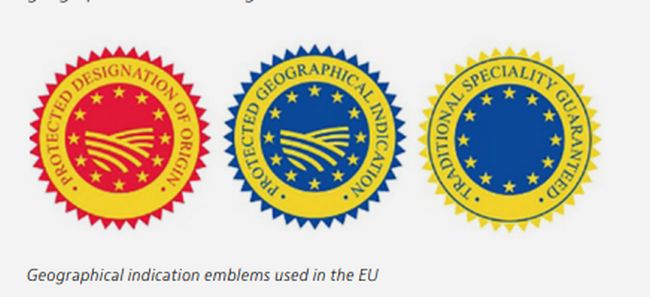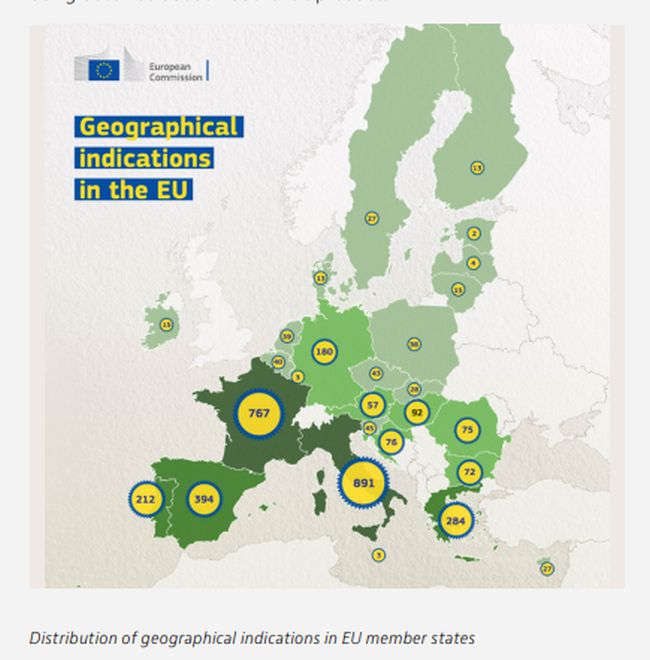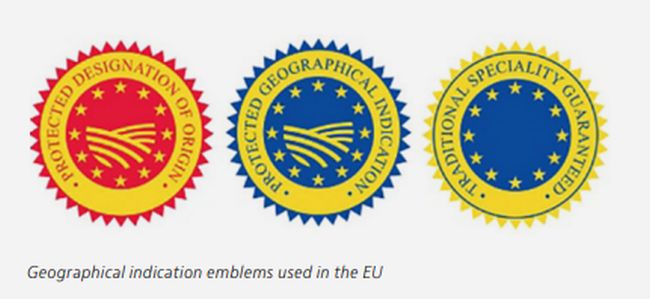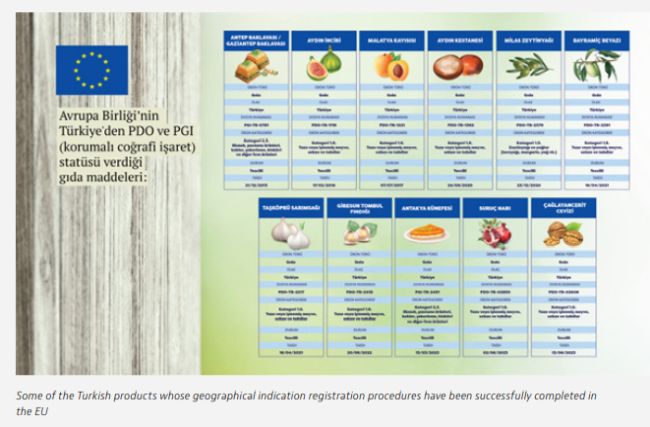I. Introduction
The delicious taste of Nigde Darboğaz Kirazı (Niğde Darboğaz Cherry), the intense spices of Afyon Pastırması (Afyon Pastrami) or the authentic aroma of Kars Balı (Kars Honey) will immediately bring the relevant regions to the minds of anyone who has ever tasted these products. If the raw material for a product is sourced from a particular region or has been produced in that region for a long time, blended with the traditional rules of that region, the product now embodies the subjectivity of that region. Geographical indications are the legal instruments to protect this traditionality, authenticity and uniqueness arising from the natural and human elements of a specific geographical area. Geographical indication registration aims to protect quality and tradition in favor of both producers and consumers, to support local production and rural development, and to combat counterfeiting.
In this article, we will examine geographical indication protection in Türkiye, and the EU, where we have reached the 14th registration as of the publication date of this article allowing various products produced in our country to spread across the world.
II. What is geographical indication?
Although the flavors such as Ezine Perniri (Ezine Cheese) or Kars Kaşarı (Kars Kashar) first come to mind when "geographical indication" is mentioned, the protection of geographical indications is not exclusive to food. Geographical indication means the protection of products that are locally distinct from similar ones and that owe this distinction to the region in which they are located.1 In line with Uğur Çolak's interpretation and pursuant to the Industrial Property Code No. 6769 (IPL), "geographical indications are signs that indicate a product identified with the region, area, territory or country of origin in terms of its distinctive quality, reputation, or other features."2
Geographical indications constitute intellectual property rights for specific products that derive their features from the geographical area in which they are produced. In the EU, as in Türkiye, where quality, reputation or other features can be attributed to the geographical origin of the product, geographical indications emphasize the relationship between the geographical area and the name of the product. Additionally, geographical indications protect the product against misuse and counterfeiting, and especially guarantee consumers the actual origin of the product. As long as the requirements set out in the geographical indication registration certificate and the relevant legislation are fulfilled, all producers in the relevant geographical area have collective rights over the protected product.
III. Geographical indication protection in Türkiye
In line with the IPL, food, agriculture, mining, handicraft and industrial products can be subject to registration of geographical indication or traditional specialty guaranteed. To be registered as a geographical indication, a product should have certain features, namely a geographical area with defined boundaries, a product that belongs to this specific area, a strong relationship between the features of this product and the geographical area, and unique features of the product.
Geographical indications are divided into two categories: protected designation of origin (PDO) and protected geographical indication (PGI). The PDOs derive all their essential features from the specific natural and manufactured factors of a region, area or, in exceptional cases, a country and are produced, processed or handled entirely within the boundaries of this geographical area. For instance, Darboğaz Kirazı (Darboğaz Cherry) and Kars Balı (Kars Honey) are PDO products.
PGI is identified with a region, area or country whose geographical boundaries are determined in terms of distinctive quality, reputation or other features, and at least one of the production processes is carried out in this specific region. For instance, Afyon Pastırması (Afyon Pastrami) is registered as a PGI. Although it does not necessarily contain the name of a specific geographical area, the names that are traditionally used and settled in daily language to indicate a product that is identified with a geographically defined region by virtue of distinctive quality, reputation or other features can also be registered as a PDO or PGI.
Traditional specialty guaranteed (TSG), on the other hand, protects names that are proven to have been used traditionally for at least 30 years to describe a product in the relevant market and that are not covered by the PDO or the PGI while some of the conditions are met. To obtain this protection, at least one of the following conditions must be satisfied: TSG must (i) originate from the traditional production, processing method or traditional composition; or (ii) be produced from traditional raw materials or ingredients. Ayvalık Tostu (Ayvalık Toast), Ezo Gelin Çorbası (Ezo Gelin Soup) and Şevket-i Bostan (Blessed Thistle Dish) are some of the products registered as TSG in Türkiye. In TSG, a specific geographical area is not defined.
In terms of geographical indications and TSG, it is obligatory to use the emblems created by the Turkish Patent and Trademark Office (TPTO) to indicate their registration:

Producers or producer groups of the product subject to the geographical indication, public institutions and organizations and public professional organizations, public interest associations, foundations and cooperatives related to the relevant geographical area are eligible to apply for geographical indication registration. In Türkiye, the chambers of commerce and industry and commodity exchanges that operate in the relevant regions generally apply for geographical indication registration.3
Geographical indication and TSG registration provide added value to the protected product, prevent infringement of intellectual property rights and counterfeits, protect producers from unfair competition, enlighten consumers who want to be informed about the quality and features of the products they consume, ensure the actual origin of the product and support local production and rural development. Geographical indications represent a distinct culture and quality and contribute to the protection and passing of traditional values of the relevant region to the next generations.
The geographical indication registration also grants significant powers to those who register or have the right to use the geographical indication. In this regard, certain prohibitions can be requested from the competent and authorized court to prevent and cease malicious acts such as: the use of the emblems of geographical indications and TSG for commercial purposes on products that do not meet the conditions specified in the registration; the misleading use or counterfeit of the geographical indication in products that do not satisfy the conditions specified in the registration; the use of incorrect or deceptive explanations regarding the features and origin of the product registered as geographical indication; and the use of the emblem in a manner that misleads the consumer.
The registration of a geographical indication not only grants significant power to registrants but also imposes various responsibilities. The most significant responsibility is the inspection of the production, placing on the market, distribution or the conformity of the use of the protected products as specified in the registration while the product is on the market by the inspection authority specified in the registration certificate after registration, and the submission of the inspection reports to the TPTO every year. Furthermore, registrants also bring producers together, work in cooperation with them and lead promotional activities related to the product. The expected results of geographical indication registration depend on the strict cooperation and rigorous work of registrants and producers.
In Türkiye, in recent years, the application and registration of geographical indications and TSG have gained significant momentum. In fact, while the number of registered geographical indications before the TPTO was 31 in 2002, this has climbed to 1,382 as of June 2023.4 The leading province in the geographical indication registration is Gaziantep, also known as the gastronomy capital of Türkiye. Gaziantep is closely followed by Konya, Diyarbakır, Şanlıurfa, Malatya and Erzurum from Central, Southern and Eastern Anatolia. The main reasons behind this momentum include the increased awareness of both producers and consumers about the importance of geographical indication registration, policies to support rural development and the added value5 that geographical indication registration provides to the product in other countries.
The contribution of geographical indication registration to economic development, especially in rural areas, is significant. It is expected that geographical indication registrations will increase the trust between the product and the consumer and thus increase the production and revenue of the product. For instance, Isparta Gülyağı (Isparta Rose Oil) was registered as a PDO in 2019. The major market for Isparta's rose products is European countries, which corresponds to more than 90% of its export revenues. In the five-year period between 2016-2020, Türkiye's average export revenue from rose products amounted to EUR 12.6 million.6 In 2019, the Rose and Aromatic Plants Application and Research Center was established within the body of Isparta University of Applied Sciences.
Geographical indications not only support economic development in the relevant region but also provide sociocultural contributions such as preventing migration from the region, promoting the territory and boosting tourism.7 For instance, in 2016 the Eastern Mediterranean Development Agency initiated the Project for Creating an Action Plan for Obtaining Geographical Indication8 in cooperation with the Ministry of Science, Industry and Technology to increase the added value of local products in Kahramanmaraş and to strengthen cooperation among all stakeholders. In the scope of this project, relevant products have been identified and the preparation of technical reports has been accelerated. The registration process of products such as Maraş Parmak/Sıkma Peyniri (Maraş Squeezed Cheese) as a geographical indication has benefited from these efforts. One of the best examples of cooperation between stakeholders is the registration of Çağlayancerit Cevizi (Çağlayancerit Walnut) in the EU.
Geographical indication registration provides substantial benefits not only to the producers, registrants or users of the product but also to consumers9. Thanks to the geographical indication registration system, which has an effective control mechanism, the consumers can be confident of the origin, quality and local features of the product they purchase. Acts that are frequently encountered and have the potential to cause dangerous consequences, such as product counterfeiting, can also be prevented in this way.
IV. Geographical indication protection in the EU
Geographical indication protection, as with other industrial property rights, is only valid in the country of registration. Therefore, having a geographical indication registration in the EU, one of the main trade partners of Türkiye, has a crucial role in enabling local products to reach their actual commercial value.
In the EU, geographical indication protection is regulated by legal instruments called regulations, which are directly applicable in all EU member states. The geographical indication application made before the European Commission provides legal protection in all EU member states. In the EU, unlike Türkiye, only food and agricultural products, spirits, wines and flavored wines can benefit from geographical indication or TSG protection. The main legislation of the EU on geographical indication protection for food and agricultural products is Regulation No. 1151/201210 and regulation on its implementation. Geographical indication protection on wine products is carried out in accordance with Regulation No. 1308/201311 and regulation on its implementation, and geographical indication protection on flavored wines is implemented under Regulation No. 2019/78712 and regulation on its implementation.
In EU legislation, as in Turkish law, geographical indication registration is divided into three categories as PDO, PGI and TSG. In the EU, as in Türkiye, to obtain PDO, all stages of production should be performed within the boundaries of a specific geographical area, whereas to receive a PGI, at least one of the production stages should be carried out in the relevant geographical area.
Pursuant to the preamble of Regulation No. 1151/2012, the main purposes of the geographical indications are to protect the reputation of the local product, to promote rural, agricultural and traditional activities, to help producers obtain a value-added price for their original products, to ensure a fair income for both farmers and producers, to contribute to the conscious choice of consumers by ensuring the dissemination of accurate information about the products, to eliminate unfair competition and to prevent consumers being deceived about inauthentic products.

In the EU, unlike Türkiye, the application and registration procedures for geographical indications are not operated by the EU Intellectual Property Office but implemented directly by the European Commission. Pursuant to Regulation No. 1151/2012, only applications for geographical indications related to agricultural products and foodstuffs can be made to the European Commission. Applications examined by the European Commission and approved for registration are published in the E-Ambrosia database.13 At the same time, since 2020, the GIview14 database publishes all geographical indications. Products entitled to geographical indication registration in third countries are protected by bilateral agreements between the EU and these respective countries. In the EU, as in Türkiye, it is obligatory to use emblems on the packaging and labels of products protected by geographical indication registration:

Application for the registration of geographical indication in the EU primarily requires the registration of geographical indication in Türkiye by applying to the TPTO. Subsequently, the applications are filed by the "group of producers of the product subject to the application, regardless of its legal form and composition" or through the TPTO and are directly addressed to the European Commission.
The sales value of products registered as geographical indications in the EU increased by 42% from 2010 to 2017 and the total economic value reached EUR 77.1 billion in 2017. Based on 2017 data, the total economic value generated by the food and beverage sector in the EU amounted to EUR 1.1 trillion, 7% of which was attributable to geographical indication products.15
Geographical indications registered in the EU also have a positive impact on the profit shares of producers. For instance, manchego cheese, produced from sheep milk in the La Mancha region of Spain, was registered as a geographical indication in 1996. The Manchego Cheese Regulatory Council was established, and 785 milk producers became involved in manchego cheese production in 2014. By 2018, the contribution of manchego cheese to the Spanish economy reached EUR 71 million.16
Aceto Balsamico di Modena (Modena Balsamic Vinegar), produced in the Moderna region of Italy, was registered as a geographical indication in 2009. Based on 2017 data, the market value of Modena balsamic vinegar reached approximately EUR 400 million and production value increased by 67% and consumer value by 108% in the six years following the geographical indication registration.17 Likewise, Tuscan oil, which is registered as a geographical indication, can be purchased at 20% higher prices than other types of oil.18
Turkish geographical indications registered in the EU are also expected to increase the economic value of the products. For instance, Malatya Kayısısı (Malatya Apricot) was registered in the EU in 2017. In 2020, 8,836 tons of apricot production yielded USD 23.4 million in revenues, whereas in 2021, 8,228 tons of production brought USD 28.1 million in revenues. Based on 2020 data from the Turkish Statistical Institute, the global production shares of Turkish geographical indication products are 8% for apricots, 3% for chestnuts, 11% for olives and 26% for figs.19
The number of geographical indications that originated in Türkiye and obtained protection in the EU has gained significant momentum in recent years and has increased to 14 products by the date of publication of this article. Currently, geographical indication applications for 43 products are pending before the European Commission. Turkish geographical indications currently protected in the EU, whose registration process has been completed in 2023, are: Antakya Künefesi, Suruç Narı (Suruç Pomegranate), Çağlayancerit Cevizi (Çağlayancerit Walnut), Gemlik Zeytini (Gemlik Olive), and Edremit Zeytinyağı (Edremit Olive Oil), Aydın İnciri ve Kestanesi (Aydın Fig and Chestnut), Gaziantep Baklavası, Malatya Kayısısı (Malatya Apricot), Milas Zeytinyağı (Milas Olive Oil), Bayramiç Beyazı (Bayramiç Nectarine), Taşköprü Sarımsağı (Taşköprü Garlic) Giresun Tombul Fındığı (Giresun Hazelnut) and Milas Yağlı Zeytini (Milas Oily Olive). Furthermore, the examination processes of the geographical indication applications filed in the EU for Ayaş Domatesi (Ayaş Tomato), Edremit Körfezi Yeşil Çizik Zeytini (Edremit Scratched Green Olives), Ezine Peyniri (Ezine Cheese) and Maraş Tarhanası (Maraş Soup with Dried Yoghurt) have been completed and published in the Official Journal of the European Union.

The European Commission also initiates new efforts to strengthen geographical indication protection. In this respect, on 31 March 2022, the European Commission adopted a proposal20 to strengthen the geographical indication system. The proposal aims to reinforce sustainability, increase sales on online platforms and enhance protection measures in the use of geographical indications in the domain name system.21 Other innovations also include the provision of access between customs and competent authorities and geographical indication producers to combat counterfeiting at EU borders, and the implementation of a single procedure for EU and non-EU applications by initiating the accelerated registration procedure.
Furthermore, on 13 April 2022, the European Commission adopted a proposal22 to extend geographical indication protection to handicraft and industrial products. According to the European Commission, the lack of protection for handicraft and industrial products across the EU reduces investment incentives for these products. Investments in these products will not only provide the establishment of niche markets but also ensure the protection of local skills and traditions in the EU. The envisaged protection aims to increase market opportunities for small producers, to enable consumers to make informed choices among quality products, as in the case of food and agricultural products, and to promote the equivalent development of handicrafts and industry.
V. Conclusion
Effective protection of IPRs is important for economic growth and competition. According to the report published in October 2022 by the EU Intellectual Property Office and the European Patent Office, IP-intensive industries23 such as manufacturing, technology and commercial services generate 47% of the EU's gross domestic product, which is worth EUR 6.4 trillion and 39.4% of all businesses (in total 81 million). Likewise, in 2019, 80.5% of EU imports and 80.1% of EU exports were carried out by IP-intensive industries.
According to the report, geographical indication products constitute 7.1% of all food and beverage sales in all EU countries. Based on the average between 2017 and 2019, geographical indications accounted for 0.1% of the EU gross domestic product, which corresponds to approximately EUR 15 billion. Geographical indication products exported from the EU made an average contribution of approximately EUR 11.3 billion to foreign trade between 2017 and 2019.24
Geographical indications ensure the transmission of local wealth from generation to generation by preserving the desired quality and also enabling people from different cultures to experience each other's customs in the most authentic form. The geographical indication emblem, which emphasizes the protection of the quality and authenticity of the product, also offers consumers the opportunity to open the door to another cultural region.
Turkish geographical indications, which are currently registered in the EU, both guarantee the origin of the distinguished products produced in the territory of Türkiye also within the EU borders and ensure that European consumers are aware that they have access to a product made by traditional methods and products are protected from counterfeit.
Footnotes
1. Metintaş, Ü. M., "Coğrafi İşaretler," Fasikül Hukuk Journal, 10.100, (2018): 241-252.
2. Çolak, U., "Türk Marka Hukuku," Onikilevha Publishing, 4th Edition (2018): 191.
3. https://www.tobb.org.tr/Sayfalar/Detay.php?rid=10466&lst=Haberler
4. https://www.turkpatent.gov.tr/haberler/gemlik-zeytini-avrupa-birligi-tarafindan-tescillendi
5. https://www.fao.org/3/i8737en/i8737en.pdf
6. Basari Hikayesi_IspartaGulYagi2023.pdf (turkpatent.gov.tr)
7. İsmail Demir, "Coğrafi İşaretlerin Sosyoekonomik Etkileri Uzmanlık Tezi," Turkish Patent and Trademark Office Geographical Indications Division, Ankara 2020.
9. "Türkiye'de Coğrafi İşaretler Ve İhracat Pazarlamasi Açisindan Değerlendirilmesi," Doğu Coğrafya Journal, June 2018, Year: 23, Number: 39, 65-82.
10. Regulation No. 1151/2012 of 21 November 2012 on quality schemes for agricultural products and foodstuffs.
11. Regulation No. 1308/2013 of 17 December 2013 establishing a common organization of the markets in agricultural products and repealing Council Regulations No. 922/72, No. 234/79, No. 1037/2001 and No. 1234/2007.
12. Regulation No. 2019/787 of 17 April 2019 on the definition, description, presentation and labelling of spirit drinks, the use of the names of spirit drinks in the presentation and labelling of other foodstuffs, the protection of geographical indications for spirit drinks, the use of ethyl alcohol and distillates of agricultural origin in alcoholic beverages, and repealing Regulation No. 110/2008
14. https://www.tmdn.org/giview/
15. European Commission, Directorate-General for Agriculture and Rural Development, "Study on economic value of EU quality schemes, geographical indications (GIs) and traditional specialities guaranteed (TSGs): final report," Publications Office, 2021.
16. Doğu Karadeniz Development Agency, "Doğu Karadeniz Coğrafi İşaret Stratejisi Araştırma Raporu ve 2020-2022 Eylem Planı," December 2019.
17. Doğu Karadeniz Development Agency, "Doğu Karadeniz Coğrafi İşaret Stratejisi Araştırma Raporu ve 2020-2022 Eylem Planı," December 2019.
18. Karademir, N. (2021), "Türkiye'de Avrupa Birliği Tescilli Coğrafi İşaretli Ürünlerin Ekonomik Kalkınma Kapsamında Değerlendirilmesi," Journal Of Social, Humanities and Administrative Sciences, 7(41):1164-1183.
19. Karademir, N. (2021). The Work Mentioned.
20. Proposal for a Regulation on European Union geographical indications for wine, spirit drinks and agricultural products, and quality schemes for agricultural products, amending Regulations No. 1308/2013, 2017/1001 and 2019/787 and repealing Regulation No. 1151/2012.
21. Geographical indications and quality schemes explained (europa.eu)
22. Regulation on geographical indication protection for craft and industrial products and amending Regulations No. 2017/1001 and No. 2019/1753 and Council Decision No. 2019/1754.
23. IP-intensive industries are defined as industries in which IPRs are used on above average per employee compared to other industries.
24. IPR-intensive industries and economic performance in the EU industry-level analysis report, fourth edition, October 2022, a joint project of the European Patent Office and European Union Intellectual Property Office.
The content of this article is intended to provide a general guide to the subject matter. Specialist advice should be sought about your specific circumstances.










